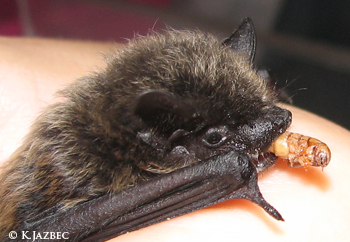 |
|
|
||
I found a bat. What should I do?
Maja Zagmajster
(The article was published in the Association's bulletin ‘Glej, netopir!’, No.1, Volume 1, September 2004)
In caves or in attics, bats are within reach of human hands but we should not disturb them, but rather, we should just quietly leave. Disturbances at roost sites are one of the major causes of harm to these legally protected mammals. But what if we find a bat lying on the ground or hanging exposed on the outside wall of a residential house during daylight? Unusual behaviour or the choice of an unusual resting site probably means that we have come across an animal that has a problem.
If a roosting bat is exposed to dangers such as traffic, dehydration from the sun or hunting animals (which includes domestic cats!), remove it as quickly as possible. However, before approaching it, be aware that bats are wild animals and won't immediately accept the well-meaning intentions behind your actions with enthusiasm. Even a much weakened creature will, out of fear, defend itself in an unfamiliar situation - often only with a threat display of an open mouth but this may quickly include the use of several sharp teeth. That is why care should be taken not to handle the animal with bare hands but rather to use an aid such as a glove, thick cloth, cardboard etc., to get the animal into a cardboard box or some other container. The container should be able to be securely closed while still allowing air to circulate freely. The bat should be put in a quiet and somewhat cooler location and SDPVN telephoned immediately. It is very important that accurate details be recorded of when and where the bat was found.
In summer it is possible to come across juvenile bats that, due to being in the early stages of learning to fly or because of clumsiness, unfortunately land on the ground. This fact alone (at least for plain-nosed bats) is not an emergency because the mother can pick them up in the evening when they call out to her. However, because of exposure to heat and hunting animals they may die before this, which is why it is best that they are removed from such a location and SDPVN contacted at once.
For research work involving bats it is necessary to have the relevant permits from the competent ministry, a few individuals in SDVPN also have experience in the rehabilitation of bats. When informed of your discovery they will be able to discuss with you what steps should be taken. In the case of a juvenile, a check is done to see if there is a maternity site nearby. If so, it is reasonably certain that the mother is also there, and the bat is placed in the maternity colony or as close to it as possible so it can climb up to her. If that isn't possible, it is temporarily removed and at early dusk, another attempt is made to put it close to the colony so it may call to its mother.
When it isn't immediately possible to return a bat to the wild, it is taken into temporary care. As soon as it recovers, it is re-released to the site where it was found. It is necessary to understand that even with the utmost of care the successful rehabilitation of an animal is not guaranteed, particularly in the case of injuries that may or may not be visible. Even in these circumstances, the effort was not in vain, as the animal was given the best chance possible of recovery.
Therefore, we ask that if you come across a bat in a weakened condition contact SDVPN or the author of this article directly on the following telephone number: 041-901-122 (or Alenka Petrinjak on 031-218-463).
 |
Savi’s pipistrelle (Hypsugo savii) in care |
 |
 |
 |
 |